13 Days of Halloween with The Owl in the Rafters: Day 2

Bismarck Kamen is back for more Halloween reviews! I’ll be skipping the introductions from here on out on the assumption that you know where you are, who I am, and what you’re reading. If for some reason you can’t answer one or all of these questions, let me direct you to yesterday’s article and we can be on our way. Today I’m going to tackle two films of a classic anime horror title, Vampire Hunter D.
Those of you who are already familiar with the franchise may realize already that these films aren’t exactly “horror” in the truest sense, but rather action/adventure sci-fi/fantasy films with a heavy touch of the occult and macabre. It’s true, the vampire aesthetic is purely superficial and the direction of the films really make no effort to be scary. Still, I can’t do a Halloween special without bumping into a vampire or two somewhere, but so long as I get to pick and choose, I’ll tackle Vampire Hunter D now, and save us all the grief of dealing with the droves of vampire charlatans flooding the market now’days. However, if you actually aren’t at all familiar with the Vampire Hunter D films, then you’re in for a special treat!
 Despite being a classic anime title, and a part of this Halloween collection, the original Vampire Hunter D is more like something out of an old cowboy film or cheap pulp novel than any kind of actual horror film. While the story itself can be likened to American monster films, the cinematography of the films is distinctly action oriented rather than crafted to evoke any strong sense of dread, fear, or anxiety.
Despite being a classic anime title, and a part of this Halloween collection, the original Vampire Hunter D is more like something out of an old cowboy film or cheap pulp novel than any kind of actual horror film. While the story itself can be likened to American monster films, the cinematography of the films is distinctly action oriented rather than crafted to evoke any strong sense of dread, fear, or anxiety.
The setting is an unusual mix of European high-fantasy, Japanese post-apocalyptic sci-fi, and American western. The main character is of course the titular vampire hunter, a man known only as D. He is notoriously a half vampire himself, and as both films make a point of remarking, he is very likely the son of the Vampire King, Count Dracula. The only other reoccurring character is a nameless symbiotic lifeform that lives in the palm of D’s left hand. This bizarre creature takes the form of a face on D’s palm, and possesses an array of convenient miscellaneous abilities. Contrasting D’s calm and quiet demeanor, the left hand is a sarcastic, wise-cracking joker and often takes the opportunity when they are alone to poke fun at D’s personality and at times complain about D’s actions putting them both in danger.
 The original Vampire Hunter D franchise started with twenty-two novels written by Kikuchi Hideyuki -just to be clear, those are actual novels and not light novels- with gorgeous illustration work by the famous Amano Yoshitaka. Amano is best known now’days as the artist behind the original six Final Fantasy games, but when he first began his work with Squaresoft, he was best known as one of the great talents behind Tatsunoko, responsible for the character designs in classics of the 60s and 70s like Tekkaman, Time Bokan, Casshern, and the world famous Gatchaman (aka Battle of the Planets, aka G-Force). He was also responsible for the designs of Sei Juushi Bismarck (Lit: “Star Gunner Bismarck”) which was later adapted to the American series Saber Rider and the Star Sheriffs: a personal favorite and indeed in part my own namesake here on 91.8 The Fan.
The original Vampire Hunter D franchise started with twenty-two novels written by Kikuchi Hideyuki -just to be clear, those are actual novels and not light novels- with gorgeous illustration work by the famous Amano Yoshitaka. Amano is best known now’days as the artist behind the original six Final Fantasy games, but when he first began his work with Squaresoft, he was best known as one of the great talents behind Tatsunoko, responsible for the character designs in classics of the 60s and 70s like Tekkaman, Time Bokan, Casshern, and the world famous Gatchaman (aka Battle of the Planets, aka G-Force). He was also responsible for the designs of Sei Juushi Bismarck (Lit: “Star Gunner Bismarck”) which was later adapted to the American series Saber Rider and the Star Sheriffs: a personal favorite and indeed in part my own namesake here on 91.8 The Fan.
Getting around to the first Vampire Hunter D film, self titled, released in 1985 in Japan and 1993 in the US, Vampire Hunter D is notable as one of the very first anime films to be released outside of Japan, which is part of what has made it a cult classic.
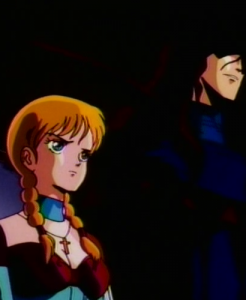 The film starts like an American Western, with a town in trouble and a mysterious stranger who wanders in to set things straight. In the year 12,090AD, a young girl named Doris Lang, living in a small town just outside the territory of a vampire lord, becomes the target of the affections of said vampire, Count Magnus Lee. The count abducts the young beauty and bites her for the first time before letting her return to her village. Before the count returns to abduct Doris for good and make her his bride, she happens upon D the vampire hunter, whom she enlists to protect her from the count.
The film starts like an American Western, with a town in trouble and a mysterious stranger who wanders in to set things straight. In the year 12,090AD, a young girl named Doris Lang, living in a small town just outside the territory of a vampire lord, becomes the target of the affections of said vampire, Count Magnus Lee. The count abducts the young beauty and bites her for the first time before letting her return to her village. Before the count returns to abduct Doris for good and make her his bride, she happens upon D the vampire hunter, whom she enlists to protect her from the count.
 The count sends his daughter, Lamica, and a mutant underling, Rei, to deal with D. Through a variety of interferences, D actually fails to protect Doris the first time around and has to rescue her from the count’s castle and in doing so fight off the count’s hordes of monstrous henchmen. All the while the film juggles this basic rescue-the-girl plot line with Rei’s deceitful attempts at stabbing his master, the count, in the back and taking his powers, and the count’s daughter Lamica’s desire to ruin her father’s funeral and keep their vampire bloodline pure.
The count sends his daughter, Lamica, and a mutant underling, Rei, to deal with D. Through a variety of interferences, D actually fails to protect Doris the first time around and has to rescue her from the count’s castle and in doing so fight off the count’s hordes of monstrous henchmen. All the while the film juggles this basic rescue-the-girl plot line with Rei’s deceitful attempts at stabbing his master, the count, in the back and taking his powers, and the count’s daughter Lamica’s desire to ruin her father’s funeral and keep their vampire bloodline pure.
The film keeps a fairly good pace in ways of toggling between brief plot developments, character drama, and glowing blood and iridescent gut spewing action. The art isn’t “bad” but it certainly is dated and that noticeable vintage look may be a little bit of a hurdle for younger viewers, never minding the actual content level to be taken into consideration. Like any good 80s anime, there is a fair amount of sexual tension, though there is minimal outright inappropriate sexual content. Again though, there is quite a lot of blood, however obviously unrealistic, and a few instances of exploding heads that I can recall off the top of mine. I almost hate to be so brief about it, but really it’s reputation precedes it. It’s a good film but not great and this really is the kind of film you should see just to say you saw it if nothing else, and if you manage to enjoy the ride then great, but if you don’t watch it and love it the first time, it’s not like it’s an act of heresy. (at least not in any sane circles)
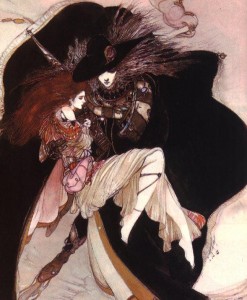 Skipping ahead in time by over a decade, in 2000 we saw the release of Vampire Hunter D: Bloodlust, based upon another of Kikuchi Hideyuki’s original novels. Amano himself has been said to have complained about the quality of the original animated film, and when comparing his own work to that of the first film, it’s really not hard to see why. So, in an attempt to better translate Amano’s remarkably distinct art style into animation, director Kawajiri Yoshiaki (famous for his work on Wicked City, Ninja Scroll, and later for the short film segment Program included in the Animatrix) and studio Madhouse pick up the mantle and try to breath life into Hideyuki’s famous vampire hunter. And really, I won’t leave you in suspense, they unquestionably succeed, surpassing the original Vampire Hunter D film by leaps and bounds.
Skipping ahead in time by over a decade, in 2000 we saw the release of Vampire Hunter D: Bloodlust, based upon another of Kikuchi Hideyuki’s original novels. Amano himself has been said to have complained about the quality of the original animated film, and when comparing his own work to that of the first film, it’s really not hard to see why. So, in an attempt to better translate Amano’s remarkably distinct art style into animation, director Kawajiri Yoshiaki (famous for his work on Wicked City, Ninja Scroll, and later for the short film segment Program included in the Animatrix) and studio Madhouse pick up the mantle and try to breath life into Hideyuki’s famous vampire hunter. And really, I won’t leave you in suspense, they unquestionably succeed, surpassing the original Vampire Hunter D film by leaps and bounds.
The film opens with a very powerful scene of the Vampire Baron Meier Link’s mechanical horse drawn carriage driving through a small human town on his way to abduct a young human girl. As the carriage bolts through the town streets, iron crosses crumple atop roofs, moving water freezes in place, and plants wither and die at the dark carriage’s passing. From here there is a seemingly non sequitur cut to a brief explanation of the film’s setting and of who D is cast over top a gorgeously painted scene of what looks like the ruins of some gothic architecture floating in space. That all will make some small amount of sense by the end of the film, but for now it’ll seem out of place. In any case this leads up to a stunning title card for the film.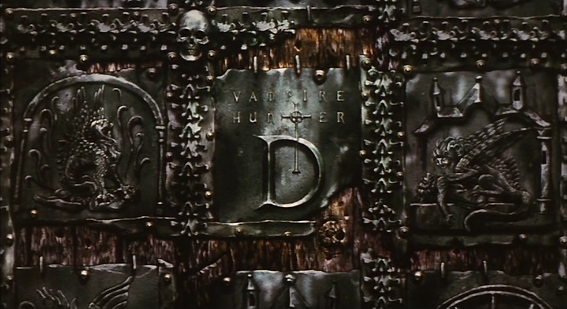
The story again details D wandering into another hunter job while on the road, but this time around both D and another band of monster hunters, The Markus Brothers, have been hired to locate and rescue (if possible) yet another a young girl who has apparently been abducted by a vampire. So, once again D must infiltrate the vampire’s lair, and save the girl (or kill her if she is found to be beyond saving), but first, a high speed horse and carriage chase!
 The twist this time around is that the rival hunter team includes a young woman named Leila, who takes on the role of D’s reluctant sidekick of sorts for part of the film. Ultimately the story behind the vampire Meier Link and his bride to be, turns out to be that the girl, Charlotte, actually is in love with Meier, rather than under some kind of hypnosis or just another damsel abductee. While D tries to sort the truth of this story out, he continues to give chase in toe with the rival hunters in pursuit of Meier’s carriage. The whole party of hunters of course fights droves of monsters all the while, with blood, guts, and exploding limbs abound.
The twist this time around is that the rival hunter team includes a young woman named Leila, who takes on the role of D’s reluctant sidekick of sorts for part of the film. Ultimately the story behind the vampire Meier Link and his bride to be, turns out to be that the girl, Charlotte, actually is in love with Meier, rather than under some kind of hypnosis or just another damsel abductee. While D tries to sort the truth of this story out, he continues to give chase in toe with the rival hunters in pursuit of Meier’s carriage. The whole party of hunters of course fights droves of monsters all the while, with blood, guts, and exploding limbs abound.
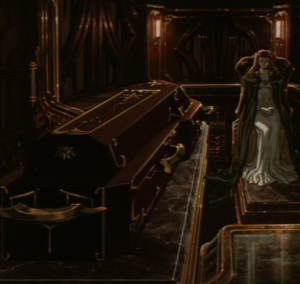 I’ll say as much now, that the story here is nothing deep or profound. There are no great deeper meanings, no intricate symbolism, no overarching moral themes, and no underlying messages. (there is a surprisingly decent love story behind all the swords and guts though) It is at its truest, a fantasy adventure; where things happen based on an in-world logic, and not for the sake of satisfying nondiagetic motives. The real appeal of the film comes from some genuinely gorgeous art and design, a solid story, and a fun action-packed chain of fight sequences. A little touch of nostalgia for those fans who had seen the original film when it first hit state-side certainly doesn’t hurt in maintaining the Vampire Hunter D name as a cult-classic must see either.
I’ll say as much now, that the story here is nothing deep or profound. There are no great deeper meanings, no intricate symbolism, no overarching moral themes, and no underlying messages. (there is a surprisingly decent love story behind all the swords and guts though) It is at its truest, a fantasy adventure; where things happen based on an in-world logic, and not for the sake of satisfying nondiagetic motives. The real appeal of the film comes from some genuinely gorgeous art and design, a solid story, and a fun action-packed chain of fight sequences. A little touch of nostalgia for those fans who had seen the original film when it first hit state-side certainly doesn’t hurt in maintaining the Vampire Hunter D name as a cult-classic must see either.
 Also worth noting is that all the characters are interestingly designed and mostly well written even given the minimal character development that most of them see: Other than D himself chasing Meier’s carriage are Borgoff, Kyle, and Nolt, a trio of hunters known as The Markus Brothers; Leila, a young woman with a personal vendetta against vampires, and the aforementioned sidekick; and Grove, a bedridden young man with a powerful drug-induced astral projection form. And then there are three main mercenary monsters: Mashira the wolfman; Caroline, a woman with the ability to change into the materials she touches; and Benge, an acrobat and knife thrower with the power to manipulate shadows, who have been hired to halt Meier’s pursuers and protect the carriage.
Also worth noting is that all the characters are interestingly designed and mostly well written even given the minimal character development that most of them see: Other than D himself chasing Meier’s carriage are Borgoff, Kyle, and Nolt, a trio of hunters known as The Markus Brothers; Leila, a young woman with a personal vendetta against vampires, and the aforementioned sidekick; and Grove, a bedridden young man with a powerful drug-induced astral projection form. And then there are three main mercenary monsters: Mashira the wolfman; Caroline, a woman with the ability to change into the materials she touches; and Benge, an acrobat and knife thrower with the power to manipulate shadows, who have been hired to halt Meier’s pursuers and protect the carriage.
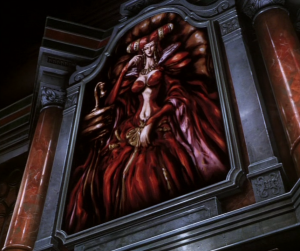 As usual, I don’t intend to spoil any big twists, but I will point out that Meier is not actually the villain of the film, but a different vampire who only appears towards the final act of the story. Also, while I won’t say exactly what it is, the very end of the film has been known to get under some people’s skin. Admittedly the conclusion of the film is a little wacky, even in a sci-fi fantasy setting, but artistically the grande finale is just as stunning as the rest of the film and does technically follow a seemingly logical progression of hints dropped over the course of the film. I only say this now so that you won’t get to the end of the story and feel like the conclusion was outrageous, absurd, and random.
As usual, I don’t intend to spoil any big twists, but I will point out that Meier is not actually the villain of the film, but a different vampire who only appears towards the final act of the story. Also, while I won’t say exactly what it is, the very end of the film has been known to get under some people’s skin. Admittedly the conclusion of the film is a little wacky, even in a sci-fi fantasy setting, but artistically the grande finale is just as stunning as the rest of the film and does technically follow a seemingly logical progression of hints dropped over the course of the film. I only say this now so that you won’t get to the end of the story and feel like the conclusion was outrageous, absurd, and random.
A fun little factoid worth noting is that this film was initially planned to be released in theaters across America as its international debut and so had the English audio track recorded first. The film was in fact released but in just six select theaters across the US. Despite this the English script is still horrendously corny, but I like to think that was done intentionally as a kind of homage to the original film. Unlike the original film however, Bloodlust takes a distinctly more romantic approach to its story. The romance between Meier and Charlotte is legitimately touching at certain points, and the characters themselves show a surprising amount of depth for a movie that really is an action film first and foremost.
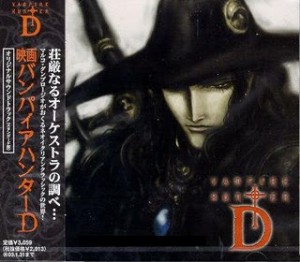 Once again, there is a good deal of sexual tension and some brief instances of nudity worth cautioning against. While the gore is surprisingly minimal, the deaths are still relatively graphic. Nothing that would merit an R rating of any sort, but again, worth pointing out for the sake of younger audiences. I didn’t find the time to say much about it, but the soundtrack is actually absolutely fantastic. The art tends to steal your attention all throughout the film though so the soundtrack tends to leave less of an impression despite being beautifully composed and performed. Unlike the first film’s passable but unspectacular soundtrack, Bloodlust sports a gorgeous, fully orchestrated soundtrack that really complements the film’s wonderfully detailed visuals.
Once again, there is a good deal of sexual tension and some brief instances of nudity worth cautioning against. While the gore is surprisingly minimal, the deaths are still relatively graphic. Nothing that would merit an R rating of any sort, but again, worth pointing out for the sake of younger audiences. I didn’t find the time to say much about it, but the soundtrack is actually absolutely fantastic. The art tends to steal your attention all throughout the film though so the soundtrack tends to leave less of an impression despite being beautifully composed and performed. Unlike the first film’s passable but unspectacular soundtrack, Bloodlust sports a gorgeous, fully orchestrated soundtrack that really complements the film’s wonderfully detailed visuals.
Things brings me to the end of these two Vampire Hunter D films. I’d like to say I recommend them both, as well as the novels, but I haven’t read the novels and the first film may just be a tad too dated to hold up well with a modern audience, so while I might recommend the first Vampire Hunter D to any anime fans who still have a love for that distinctly 80s look, to the rest of you I’ll at least say that Vampire Hunter D: Bloodlust is an absolute must see.





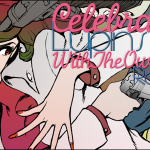
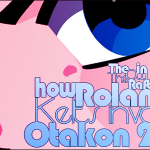
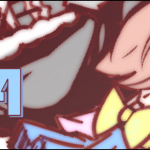









Such a classic..
Got to love the classic Vampire Hunter D. Going to have to check out the newer release sometime if it’s even half as good as the original.
I love Vampire Hunter D. The second movie was also quite interesting as well and certainly was visually stunning.